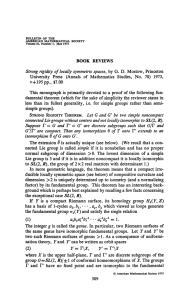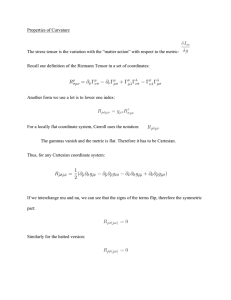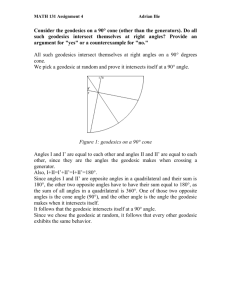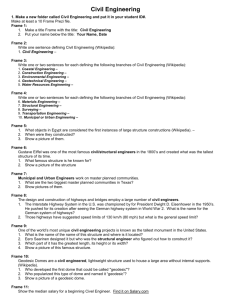INVOLUTIONS AND SIMPLE CLOSED GEODESICS ON RIEMANN SURFACES Paul Schmutz Schaller
advertisement
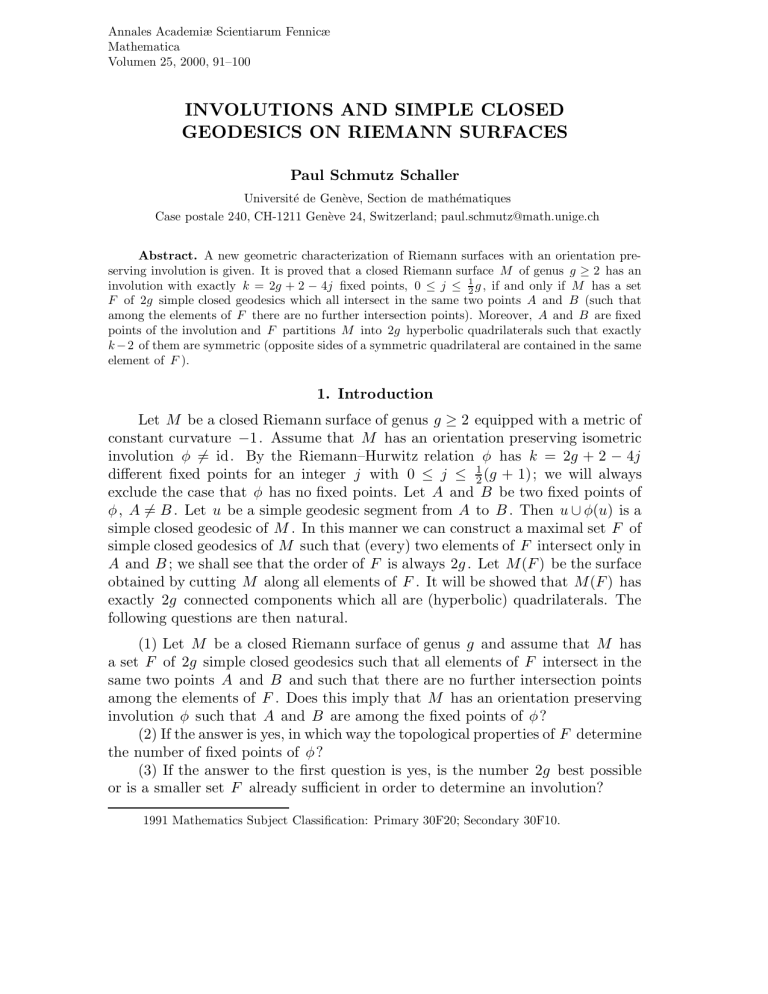
Annales Academiæ Scientiarum Fennicæ
Mathematica
Volumen 25, 2000, 91–100
INVOLUTIONS AND SIMPLE CLOSED
GEODESICS ON RIEMANN SURFACES
Paul Schmutz Schaller
Université de Genève, Section de mathématiques
Case postale 240, CH-1211 Genève 24, Switzerland; paul.schmutz@math.unige.ch
Abstract. A new geometric characterization of Riemann surfaces with an orientation preserving involution is given. It is proved that a closed Riemann surface M of genus g ≥ 2 has an
involution with exactly k = 2g + 2 − 4j fixed points, 0 ≤ j ≤ 21 g , if and only if M has a set
F of 2g simple closed geodesics which all intersect in the same two points A and B (such that
among the elements of F there are no further intersection points). Moreover, A and B are fixed
points of the involution and F partitions M into 2g hyperbolic quadrilaterals such that exactly
k − 2 of them are symmetric (opposite sides of a symmetric quadrilateral are contained in the same
element of F ).
1. Introduction
Let M be a closed Riemann surface of genus g ≥ 2 equipped with a metric of
constant curvature −1 . Assume that M has an orientation preserving isometric
involution φ 6= id. By the Riemann–Hurwitz relation φ has k = 2g + 2 − 4j
different fixed points for an integer j with 0 ≤ j ≤ 21 (g + 1) ; we will always
exclude the case that φ has no fixed points. Let A and B be two fixed points of
φ , A 6= B . Let u be a simple geodesic segment from A to B . Then u ∪ φ(u) is a
simple closed geodesic of M . In this manner we can construct a maximal set F of
simple closed geodesics of M such that (every) two elements of F intersect only in
A and B ; we shall see that the order of F is always 2g . Let M (F ) be the surface
obtained by cutting M along all elements of F . It will be showed that M (F ) has
exactly 2g connected components which all are (hyperbolic) quadrilaterals. The
following questions are then natural.
(1) Let M be a closed Riemann surface of genus g and assume that M has
a set F of 2g simple closed geodesics such that all elements of F intersect in the
same two points A and B and such that there are no further intersection points
among the elements of F . Does this imply that M has an orientation preserving
involution φ such that A and B are among the fixed points of φ ?
(2) If the answer is yes, in which way the topological properties of F determine
the number of fixed points of φ ?
(3) If the answer to the first question is yes, is the number 2g best possible
or is a smaller set F already sufficient in order to determine an involution?
1991 Mathematics Subject Classification: Primary 30F20; Secondary 30F10.
92
Paul Schmutz Schaller
Theorem A. The answer to the first question is yes.
Moreover (this concerns the second question), if k > 0 is the number of
fixed points of φ and s the number of connected components of M (F ) which
are symmetric quadrilaterals, then k − 2 = s . (In a symmetric quadrilateral the
opposite sides are parts of the same element of F .)
Theorem B. Concerning the third question, the number 2g is best possible.
Namely, for every integer g ≥ 2 there exists a closed surface M of genus g with
a set F of 2g − 1 elements which does not induce an involution.
The proofs are given in Section 2.
One may ask whether the intersection points of the geodesics in Theorem A
and Theorem B are Weierstrass points (for general references on Weierstrass points
see [4], [2]). By Lewittes [6], the fixed points of an orientation preserving involution
φ are ordinary (or 1 -fold) Weierstrass points if φ has more than four fixed points.
If φ has four fixed points, then, by Accola [1], the fixed points are at least 2 fold Weierstrass points (but, in general, not ordinary Weierstrass points). Finally,
if the involution φ has only two fixed points, then these fixed points may miss
the dense set of q -fold Weierstrass points, q = 1, 2, 3, . . . , as has been showed by
Guerrero [5]. The latter may well be true also for the intersection points of the
“counter-examples” in Theorem B.
In the hyperelliptic case we also have the following related result.
Theorem C (Schmutz Schaller). Let M be a closed surface of genus g . Then
M is hyperelliptic if and only if M has a set G of at least 2g − 2 simple closed
geodesics which all intersect in the same point such that among the elements of
G there are no further intersection points.
This result has first been proved in [7] (see also the survey paper [8] and [9]).
Note that by sets of simple closed geodesics which all intersect in a unique point
(as in Theorem C), other involutions than the hyperelliptic one cannot be characterized.
For some results related to those of this paper see Birman and Series [3].
Acknowledgment. I thank the referee for helpful comments.
2. Geometric characterization of involutions
Definition (i) A surface is a Riemann surface equipped with a metric of
constant curvature −1 .
(ii) A (g, n) -surface is a surface of genus g with n boundary components
which are simple closed geodesics. A closed surface is a compact surface without
boundary.
(iii) A simple geodesic is one without selfintersections.
(iv) An involution is an isometry φ 6= id with φ2 = id ( id is the identity).
Involutions and simple closed geodesics on Riemann surfaces
93
(v) Let M be a closed surface. A geodesic 2 -set F of order k > 0 on M is a
set of k different simple closed geodesics of M which all intersect in the same two
points, the intersection points of F , such that among the elements of F , there are
no further intersection points. Define by M (F ) the surface obtained by cutting
M along all elements of F .
(vi) Let M be a closed surface and F a geodesic 2 -set. Let A and B be the
intersection points of F . Let u ∈ F . Then u is separated by A and B into two
parts, the segments of u .
Remark and Definition. Let N be (the closure of) a connected component
of M (F ) ( F and M are defined as above). Then the boundary of N consists of a
number of simple closed curves which are called boundary components of N ; they
are considered as disjoint, taking different copies of A and B on each boundary
component. If N has genus zero and only one boundary component, then I call
N a polygon and treat the vertices of this polygon as different copies of A and B ,
respectively. The same convention is used in related cases.
Lemma 1. Let M be a closed surface of genus g with an orientation preserving involution φ with exactly k fixed points. If g is even, then k ≡ 2 mod(4) .
If g is odd, then k ≡ 0 mod(4) .
Proof. This is a consequence of the Riemann–Hurwitz relation.
Remark. Let M be a closed surface of genus g which has an orientation
preserving involution φ with fixed points. It then follows by Lemma 1 that φ has
at least two fixed points. This fact will be used throughout without comment.
Lemma 2. Let M be a closed surface of genus g . Let A and B be two
different points on M . Let F be a set of 4g simple geodesic segments starting
in A and ending in B which are all mutually disjoint in M \ {A, B} . Then
the elements of F cut M into exactly 2g connected components which all are
hyperbolic quadrilaterals.
Proof. Let F 0 ⊃ F such that all elements of F 0 are simple geodesic segments
starting in A and ending in B and such that all elements of F 0 are mutually
disjoint in M \ {A, B} . Assume further that F 0 is maximal with respect to these
conditions. Let M (F 0 ) be the surface obtained by cutting M along all elements
of F 0 . Define M (F ) analogously.
Let N be a connected component of M (F 0 ) . Then each boundary component
of N contains an even number of geodesic segments. Assume that N has two
different boundary components b1 and b2 . Let A1 be a copy of A on b1 and let
B2 be a copy of B on b2 . Since N is convex, N contains a simple geodesic segment
vN from A1 to B2 . Since v(N ) is not in F 0 , this contradicts the maximality of F 0 .
Assume now that N has only one boundary component b and that N has
genus g(N ) > 0 . Then N has a simple geodesic segment wN 6⊂ b from a copy of
A on b to a copy of B on b . This again contradicts the maximality of F 0 .
94
Paul Schmutz Schaller
Assume finally that N has only one boundary component b and that g(N ) =
0 . It follows that N is a polygon. Assume that b has at least six vertices (recall
that the number of vertices must be even). Then b contains a copy A1 of A and
a copy B1 of B such that N has a simple geodesic segment t(N ) from A1 to B1 ,
t(N ) 6⊂ b . This contradicts the maximality of F 0 .
We therefore have proved that each connected component of M (F 0 ) is a
quadrilateral (note that a connected component of M (F 0 ) cannot be a polygon
with two sides).
Assume that M (F 0 ) has q connected components Q1 , Q2 , . . . , Qq . Let S be
the sum of all (inner) angles of the quadrilaterals Qi , i = 1, . . . , q . Then S = 4π
since all vertices of Qi are copies of A and B . We obtain
q
X
i=1
vol(Qi ) = 2qπ − 4π = vol(M ) = 4(g − 1)π
where vol is the (hyperbolic) volume. This implies that q = 2g . Therefore, there
are 8g segments as sides of the quadrilaterals Qi , i = 1, . . . , 2g . It follows that
F 0 has order 4g . This proves F = F 0 and hence the lemma.
Corollary 1. Let M be a closed surface of genus g . Let F be a geodesic
2 -set of M of order 2g . Then M (F ) has 2g connected components which all are
hyperbolic quadrilaterals.
Proof. Clear by Lemma 2.
Corollary 2. Let M be a closed surface of genus g which has an orientation
preserving involution φ with fixed points. Let A and B be fixed points of φ ,
A 6= B . Then M has a geodesic 2 -set of order 2g with fixed points A and B .
Proof. Let F be a maximal geodesic 2 -set on M with intersection points A
and B . It is clear that F is not empty since M has a simple geodesic segment
u1 from A to B which implies that u = u1 ∪ φ(u1 ) is a simple closed geodesic
passing through A and B . Let N be a connected component of M (F ) . Assume
that N has a simple geodesic segment v starting in a copy of A (on a boundary
component of N ) and ending in a copy of B (on a boundary component of N )
such that v is not a segment of an element of F . Then v ∪ φ(v) is a simple closed
geodesic, v ∈
/ F , and F ∪ {v} is a geodesic 2 -set. This contradicts the maximality
of F . It therefore follows analogously as in the proof of Lemma 2 that N must
be a quadrilateral, that the number of connected components of M (F ) is 2g , and
that the order of F is 2g .
Definition. Let F be a geodesic 2 -set of order 2g in a closed surface M of
genus g .
(i) A quadrilateral of F is a connected component of M (F ) .
Involutions and simple closed geodesics on Riemann surfaces
95
(ii) Let Q be a quadrilateral of F . Then the sides si (in the natural order)
of Q are segments of elements ui of F , i = 1, 2, 3, 4 . If u1 = u3 and u2 = u4 ,
then Q is called symmetric.
Lemma 3. Let F be a geodesic 2 -set of order 2g in a closed surface M of
genus g . Let Q be a quadrilateral of F . Let u1 , . . . , u4 be the elements of F
which form the boundary of Q . Then there is a quadrilateral Q0 of F such that
ui , i = 1, . . . , 4 , form the boundary of Q0 and Q 6= Q0 if and only if Q is not
symmetric. Moreover, Q0 has the same inner angles as Q .
s3
B
s4
Q
s2
B
s1
A
t1
A
t2
Q0
B
Figure 1. The quadrilaterals Q and Q0 .
Proof. (i) We may assume that the notation is such that the segments si ⊂ ui
which form the boundary of Q , appear in the natural order, counter-clockwise say
(compare Figure 1). Let αi be the directed angle from si to si+1 , i = 1, . . . , 4
(taking the indices modulo 4 ), such that αi is an inner angle of Q . Then all four
angles αi , i = 1, . . . , 4 , are measured clockwise. Let A and B be the intersection
points of F where the notation is such that A is a vertex in Q between s1 and
s2 as well as between s3 and s4 .
(ii) For each i ∈ {1, 2, 3, 4} let ti ⊂ ui be the segment of ui which is different
from si . Denote by βi the directed angle from ti to ti+1 , measured clockwise,
i = 1, . . . , 4 . Then αi = βi , i = 1, . . . , 4 . It follows that there is a quadrilateral
Q0 of F , containing t1 and t2 as sides, such that β1 is an inner angle of Q0 .
Since the vertex between t1 and t2 in Q0 is a copy of A , t2 will end in a copy
B1 of B . In order to obtain the other side of Q0 ending in B1 , we have to turn
clockwise around B from u2 to the next element of F . But this must be u3 (by
the existence of Q ), more precisely, this third side of Q0 is t3 . The same argument
proves that t4 is the fourth side of Q0 . It also follows that β1 , . . . , β4 are the inner
angles of Q0 , therefore, Q0 and Q have the same inner angles.
(iii) By the existence of Q , u2 is the next element of F when we turn clockwise
around A from u1 , and u4 is the next element of F when we turn clockwise
around A from u3 . It follows that u1 = u3 if and only if u2 = u4 . Assume that
Q is symmetric. It follows by (ii) that ti and si+2 is the same segment of ui ,
i = 1, . . . , 4 (taking the indices modulo 4 ), which shows that Q = Q0 .
96
Paul Schmutz Schaller
On the other hand, if Q = Q0 then ti must be a side of Q , i = 1, . . . , 4 .
Since ui is simple, it follows that ti equals si+2 , i = 1, . . . , 4 , and hence u1 = u3
and u2 = u4 .
Corollary 3. Let F be a geodesic 2 -set of order 2g in a closed surface M
of genus g . Let Q be a quadrilateral of F , let u1 , . . . , u4 be the elements of F
which form the boundary of Q . Then either all elements ui , i = 1, 2, 3, 4 , are
different or Q is symmetric. In the latter case, M has an embedded (1, 1) -surface
S(Q) which contains Q .
Proof. It was already shown during the proof of Lemma 3 that either all four
elements ui , i = 1, 2, 3, 4 , are different or Q is symmetric. Assume that Q is
symmetric. Let the notation be such that u1 = u3 and u2 = u4 . Let s2 and s4
be the segments of u2 . Cut M along u1 yielding a (g − 1, 2) -surface M 0 ; denote
the boundary geodesics of M 0 by v1 and w1 . It then follows that M 0 contains a
unique simple closed geodesic z and an embedded (0, 3) -surface Y with boundary
geodesics z, v1 , w1 such that s2 ⊂ Y (in M , the subsurface Y is an embedded
(1, 1) -surface). Since s4 is freely homotopic to s2 , it follows that s4 is contained
in Y .
Corollary 4. Let M be a closed surface M of genus g which has an orientation preserving involution φ with k > 0 fixed points. Let A and B be fixed
points of φ . Let F be a geodesic 2 -set of order 2g with intersection points A
and B . Then among the 2g quadrilaterals of F , there are exactly k − 2 which
are symmetric.
Proof. Let s be the number of symmetric quadrilaterals of F .
If k > 2 , then φ has a fixed point C ∈
/ {A, B} . C lies in the interior of a
quadrilateral QC of F ( C cannot lie on an element of F since A and B already
lie on each element of F ). It follows that φ(QC ) = QC which implies that QC is
symmetric. This proves k − 2 ≤ s .
On the other hand, let Q be a quadrilateral of F which is symmetric. By
Corollary 3, M has an embedded (1, 1) -surface S(Q) which contains Q . To Q
correspond two elements u1 and u2 of F which lie in S(Q) . Every (1, 1) -surface
S has a (hyperelliptic) involution ψ with three fixed points, and if v and w are
two simple closed geodesics of S which intersect twice, then both intersection
points are among the fixed points of ψ . It follows that the hyperelliptic involution
ψ of S(Q) is the restriction of φ and therefore, φ has a third fixed point in S(Q)
which lies in the interior of Q . This proves s ≤ k − 2 .
Definition. Let F be a geodesic 2 -set of order 2g in a closed surface M of
genus g . Let u ∈ F . Then u is called symmetric if the two segments of u have
equal length.
Corollary 5. Let F be a geodesic 2 -set of order 2g in a closed surface M
Involutions and simple closed geodesics on Riemann surfaces
97
of genus g . Let Q be a quadrilateral of F which is symmetric. Let u ∈ F such
that the segments of u are sides of Q . Then u is symmetric.
Proof. By Corollary 3, Q is contained in an embedded (1, 1) -surface S(Q)
of M . As already noted in the proof of Corollary 4, S(Q) has a hyperelliptic
involution ψ and the intersection points of F are among the fixed points of ψ .
This proves the corollary.
Lemma 4. Let Q1 and Q2 be quadrilaterals with sides ai , bi , ci , di , i = 1, 2
(in the natural order). Let Q1 and Q2 have the same inner angles (the angle
between a1 and b1 equals the angle between a2 and b2 , and so on). Then
(i) L(a1 ) = L(a2 ) if and only if Q1 and Q2 are isometric, and
(ii) L(a1 ) > L(a2 ) ⇐⇒ L(b1 ) < L(b2 )
(where L(x) is the length of x ).
Proof. (i) is obvious by hyperbolic trigonometry so assume that L(a1 ) >
L(a2 ) . It then follows by (i) that L(b1 ) 6= L(b2 ) . Assume that L(b1 ) > L(b2 ) .
Let Ri be the vertex of Qi between ai and bi , i = 1, 2 . In the hyperbolic plane
place Q2 on Q1 such that R1 = R2 and such that a2 ⊂ a1 and b2 ⊂ b1 . Then c1
and c2 cannot intersect (since Q1 and Q2 have the same angles). By the same
argument also d1 and d2 cannot intersect. It follows that Q2 ⊂ Q1 . But since
Q1 and Q2 have the same volume, this yields a contradiction.
Corollary 6. Let F be a geodesic 2 -set of order 2g in a closed surface M
of genus g . Let Q be a quadrilateral of F which is not symmetric. Let u1 , . . . , u4
be the four elements of F which form the boundary of Q . Then either all ui ,
i = 1, . . . , 4 , are symmetric or none.
Proof. Let Q0 be defined as in Lemma 3. Assume that one of the ui is
symmetric. Since Q and Q0 have different segments, it follows by Lemma 4(i)
that Q and Q0 are isometric and therefore, all ui are symmetric.
Theorem 1. Let M be a closed surface of genus g . Then M has a geodesic
2 -set F of order 2g if and only if M has an orientation preserving involution with
fixed points.
Proof. One direction has already been proved by Corollary 2. Assume now
that M has a geodesic 2 -set F of order 2g with intersection points A and B .
Assume that F has a symmetric quadrilateral. It then follows by Corollary 5 and
Corollary 6 (and by the fact that all elements of F intersect in A ) that every
element of F is symmetric.
Let φ be the π -rotation around A . It follows that, by φ , the quadrilaterals
of F are mapped into quadrilaterals of F . More precisely, φ(Q) = Q if Q is
symmetric (by the proof of Corollary 4) and φ(Q) = Q0 if Q is not symmetric
where Q0 is defined as in Lemma 3. It follows that φ is an involution of M .
98
Paul Schmutz Schaller
We therefore can assume that none of the quadrilaterals of F is symmetric.
Denote the elements of F by u1 , . . . , u2g such that the ui lie in the natural order
around A . Denote the segments of ui by vi and vi+2g , i = 1, . . . , 2g , such that
the vj lie in the natural order around A ( j = 1, . . . , 4g ). If an element of F is
symmetric, then all elements of F are symmetric by Corollary 6. Assume that the
elements of F are not symmetric and that v1 > v2g+1 . It then follows by Lemma 4
that v2 < v2g+2 . The same argument shows that v3 > v2g+3 . By repeating this
argument we obtain that v2g < v4g and hence v2g+1 > v1 , a contradiction. We
have therefore proved that all elements of F are symmetric. This implies that the
π -rotation around A is an involution of M .
Theorem 2. For every integer g ≥ 2 there exists a closed surface M of
genus g which has a geodesic 2 -set F of order 2g − 1 with intersection points A
and B , but no involution such that A and B are among the fixed points of M .
Proof. Let ε > 0 be small. For 1 ≤ t < 2 , let T (t) be a (hyperbolic) triangle
with (inner) angles
α(t) =
tπ
− ε,
4(2g − 1)
β(t) =
tπ
+ ε,
4(2g − 1)
γ=
π
.
2g − 1
Denote by A, B, C the vertices of T (t) and by a, b, c the sides of T (t) (with the
usual convention of notation: a is opposite to A and to α(t) , and so on). Take
4g − 2 copies of T (t) and glue them along a or along b such that the vertex C is
the same for all 4g − 2 copies. We obtain a 4g − 2 -gon P (t) where all sides have
the length L(c) and where 2g − 1 angles are 2α(t) and 2g − 1 angles are 2β(t) .
Denote the sides of P (t) by ci , i = 1, . . . , 4g − 2 , in the natural order.
(i) Assume now that g is odd. Let t = 1 . Let S be a triangle of (hyperbolic)
area 21 π such that two sides x and y of S have the same length while the third
side z of S has length L(c) . It is clear that S exists and is unique up to isometry.
Glue a copy S1 (with sides x1 , y1 , z1 ) of S along z1 and along c1 of P (t) such
that the interior of P (t) is not intersected by S1 . Glue a copy S2 (with sides
x2 , y2 , z2 ) of S along z2 and along c2g of P (t) such that the interior of P (t) is
not intersected by S2 and such that x2 is opposite to x1 and y2 is opposite to
y1 (the orientation of S1 and S2 is the same). Thereby P (t) has been enlarged
to a 4g -gon R(t) . By construction, the area of R(t) is 4π(g − 1) . R(t) is the
fundamental domain of a closed surface M (t) of genus g and we obtain M (t) by
the following identifications of the sides of R(t) (the identification is symbolized
by a + ).
x1 + x 2 , y 1 + y 2 ,
c4m−2 + c4m ( m = 1, . . . , 12 (g − 1) ),
c4m + c4m+2 ( m = 12 (g + 1), . . . , g − 1 ),
c4m−1 + c4m+1 ( m = 1, . . . , g − 1 ).
Involutions and simple closed geodesics on Riemann surfaces
99
Let T be one of the copies of T (t) in R(t) . By construction, there is a copy
T of T (t) in R(t) such that the side b1 of T 0 is the prolongation of the side
a1 of T . Let u1 = a1 ∪ b1 . It is then easy to verify that u1 is a simple closed
geodesic in M (t) . Since we have 4g − 2 copies of T (t) we obtain 2g − 1 simple
closed geodesics ui , i = 1, . . . , 2g − 1 , in M (t) which all intersect in C and in V
where V corresponds to the 4g vertices of R(t) (which all are identified in M (t) ).
Therefore, {u1 , . . . , u2g−1 } is a geodesic 2 -set of order 2g − 1 . Since L(a) < L(b) ,
M (t) has not an involution with fixed points C and V .
(ii) Assume now that g is even. Let W be a triangle with three sides of equal
length L(c) . Denote by δ an (inner) angle of W . Glue a copy W1 of W along
c1 and glue a copy W2 of W along c2g (such that the interior of P (t) is not
intersected by Wi , i = 1, 2 ). Thereby, P (t) has been enlarged to a 4g -gon R(t) .
Denote the new sides of R(t) by x1 , y1 (coming from W1 ) and by x2 , y2 (coming
from W2 ) such that x1 is a neighbour of c4g−2 and x2 is a neighbour of c2g−1 .
Let us now assume that t is chosen such that the area of R(t) is
0
(1)
(4g − 2)π − 6δ − (4g − 2) α(t) + β(t) = 4π(g − 1).
R(t) is then the fundamental domain of a closed surface M (t) of genus g and we
obtain M (t) by the following identifications of the sides of R(t) .
x1 + c4g−3 , y1 + c3 , x2 + c2g−2 , y2 + c2g+2 ,
and, if g 6= 2 ,
c4m−2 + c4m ( m = 1, . . . , 12 (g − 2) ),
c4m + c4m+2 ( m = 12 (g + 2), . . . , g − 1 ),
c4m+1 + c4m+3 ( m = 1, . . . , g − 2 ).
It is now easy to see (as above in (i)) that M (t) has a geodesic 2 -set of order
2g − 1 with intersection points C and V , but C cannot be a fixed point of an
involution since L(a) < L(b) .
It remains to show that (1) is possible. Note first that when (1) holds, then
(2)
δ = 16 π(2 − t).
Let t = 1 . It then follows (by a calculation) that cosh L(c) > 21 (if ε is small
enough) which yields cos δ < 21/22 and δ is too small (by (2) δ should equal π/6 ).
Let now t −→ 2 . Then L(c) is shorter than in the case t = 1 and therefore, δ
becomes larger than in the case t = 1 . But now δ is too large since, by (2), δ
should tend to zero. This proves that (1) is possible.
References
[1]
[2]
Accola, R.D.M.: On generalized Weierstrass points on Riemann surfaces. - In: Modular
Functions in Analysis and Number Theory, University Pittsburgh, 1983, 1–19.
Accola, R.D.M.: Topics in the theory of Riemann surfaces. - Lecture Notes in Math.
1595, Springer-Verlag, 1994.
100
[3]
[4]
[5]
[6]
[7]
[8]
[9]
Paul Schmutz Schaller
Birman, J.S., and C. Series: Geodesics with multiple self-intersections and symmetries
on Riemann surfaces. - In: Low-dimensional Topology and Kleinian Groups, edited
by D.B.A. Epstein, Cambridge University Press, 1986, 3–11.
Farkas, H.M., and I. Kra: Riemann Surfaces, 2nd ed. - Springer-Verlag, 1992.
Guerrero, I.: Automorphisms of compact Riemann surfaces and Weierstrass points. In: Riemann Surfaces and Related Topics, edited by I. Kra and B. Maskit, Princeton
University Press, 1981, 215–224.
Lewittes, J.: Automorphisms of compact Riemann surfaces. - Amer. J. Math. 85, 1963,
732–752.
Schmutz Schaller, P.: Geometric characterization of hyperelliptic Riemann surfaces. Ann. Acad. Sci. Fenn. Math. 25, 2000, 85–90.
Schmutz Schaller, P.: Geometry of Riemann surfaces based on closed geodesics. - Bull.
Amer. Math. Soc. 35, 1998, 193–214.
Schmutz Schaller, P.: Teichmüller space and fundamental domains of Fuchsian groups.
- Enseign. Math. (to appear)
Received 7 April 1998


